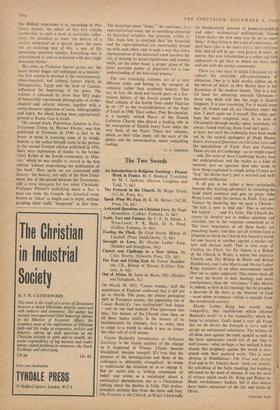Event plus Interpretation
The World History of the Jewish People. Volume il: At the Dawn of Civilisation. Edited by E. A. Speiser. (W. H. Allen, S gns.) Palestinian Judaism in New Testament Times. By Werner Forster. Translated by Gordon E. Harris. (Oliver and Boyd, 30s.) Behind the Wall: The. Story of the Ghetto. By Poul Borchsenius. Translated by Reginald Spink. (Allen and Unwin, 30s.) The Chains Are Broken: The Story of Jewish Emancipation. By Poul Borchsenius. Trans- lated by Michael Heron. (Allen and Unwin, 28s.)
HISTORY, as the. chroniclers of ancient Israel long ago discovered, is very much more than a mere
record of events. Indeed, those who were in- terested only in events were referred, perhaps a little scathingly, to such long-lost works as the Book of Jashar and the Book of the Wars of the
Lord. That these, and who knows how many, other such, contemporary records, have so com-
pletely disappeared, serves only to underline the truth of the thesis advanced by Rabbi Dr. A. Altmann, a very distinguished Jewish scholar, that 'history is always event plus interpretation, because the event as such has no value and con- veys no meaning unless it is lit up by some source of illumination which throws upon it a certain meaning and significance in a wider context.'
This thesis is well illustrated by each of the volumes here under review. The first, At the Dawn of Civilisation, deals with `the ancient Near East as a background for the Biblical ex- perience.' As such, it forms the introduction to a World History of the Jewish People, first con- ceived in 1947, begun in 1952, and to be com- pleted, if all goes according to plan, by 1965, in twenty volumes of approximately 500 pages each! The journey promises -to be a long one, but if this first volume is anything to go by it is likely to prove very rewarding. Starting from the Biblical experience it is, according to Pro- fessor Speiser, the editor of this first volume (authorship in such a work is inevitably collec- tive), the intention to trace 'the history of a society embarked on a special quest, the quest for an enduring way of life, a way of life possessing universal validity. Everything else is subordinated to and co-ordinated with that single dominant theme.'
But since, as Professor Speiser points out, 'the quest neither began nor continued in a vacuum,' this first volume is devoted to the environmental, ethno-linguistic and cultural factors which, in Mesopotamia, Egypt and the land of Canaan, influenced the beginnings of the quest. The volume, is enhanced by more than fifty pages of beautifully reproduced photographs of archae- ological and cultural interest, together with a comprehensive apparatus of notes, bibliographies and index, the whole having been appropriately printed at Ramat Can in Israel.
The second work, Palestinian Judaism in New Testament Times, by Werner Forster, was first published in Germany in 1940—a fact to be borne in mind in assessing some of its trends. Indeed, as the author himself states in his preface to the second German edition published in 1954, there were expressions of thanks `to the former Chief Rabbi of the Jewish community in Miln- ster,' which he was unable to record in the first edition 'without jeopardising the publication of the book.' Here again we are concerned with history—the history, not only of the. New Testa- ment, but of the period between the Testaments, still a terra incognita for too many Christians. Professor Forster's underlying thesis is that `a man can study the Gospels, the historical event known as "Jesus" at length and in depth, without grasping what really "happened" at that time. The historical event "Jesus,"' he continues, 'is a supra-historical event, not as something alongside its historical actually, but precisely within it.' This leads him to conclude that 'the historical and the supra-historical are inextricably bound up with each other, and in such a way that every representation of the historical event involves the risk of missing its actual significance and content while, on the other hand, a proper grasp of the latter provides points of departure for a true understanding of the historical process.'
The two remaining volumes are of a very different order and belong to the category of romantic rather than academic history. They are, in fact, the third and fourth parts of a five- volume history of the Jewish people from the final collapse of the Jewish State under Hadrian in AD 135 to the re-establishment of the State of Israel in 1948. Their author, Poul Borchsenius, is a recently retired Pastor of the Danish Lutheran Church who played a leading role in the evacuation of Danish Jewry from under the very heels of the Nazis. These two volumes, which, as their titles imply, tell the story of the ghetto and the emancipation, make compelling reading.
C. C. SIMPSON



































 Previous page
Previous page